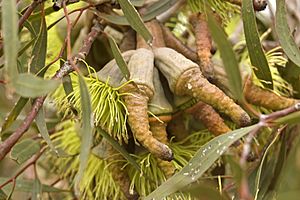Warted yate facts for kids
The Warted yate, also known as Eucalyptus megacornuta, is a special type of Eucalyptus tree. It only grows in the southwest part of Western Australia. It gets its name "warted" because of the bumpy look of its fruit. This tree is known for its beautiful yellow-green flowers.
Quick facts for kids Warted yate |
|
|---|---|
 |
|
| Conservation status | |
| Scientific classification | |
| Genus: |
Eucalyptus
|
| Species: |
megacornuta
|
Contents
What Does It Look Like?
This tree usually grows to be about 4 to 12 metres (13 to 39 ft) tall. Its top part, called the crown, can spread out up to 6 m (20 ft) wide. The Warted yate can look like a small tree or even a large bush. It has smooth bark that can be brown, grey-red, or green on its trunk and branches.
Its leaves are dull green, thick, and the same color on both sides. They are arranged in a way that means they don't grow directly opposite each other. The leaves are shaped like a spear (called lanceolate) or an oval (called elliptic) and get narrower towards the bottom.
Flowers and Fruit
The Warted yate produces large, yellow-green flowers. These flowers bloom from July to October in its natural home. Each group of flowers, called a conflorescence, has three to seven smaller flower clusters. These clusters grow on flat stems called peduncles.
After the flowers, the tree grows fruits, which are also called capsules. These fruits grow close together and don't have their own stems. They are shaped like a bell (called campanulate) and have one main ridge with many smaller, weaker ridges. The capsules are about 1.8 to 4 centimetres (0.7 to 1.6 in) long and 2.2 to 2.5 cm (0.9 to 1.0 in) wide. When they open, three parts stick out to release the seeds.
How It Got Its Name
A botanist named Charles Austin Gardner officially described this species in 1942. He wrote about it in a scientific paper called Contributiones Florae Australiae Occidentalis. The first sample of the plant used to describe the species was collected by Gardner in 1935 near a place called Ravensthorpe.
The Warted yate looks a lot like two other related eucalyptus trees: the Beaufort Inlet Mallee (Eucalyptus newbeyi) and Burdett's Mallee (Eucalyptus burdettiana).
Where Does It Grow?
You can find the Warted yate on hillsides and in creek beds along the south coast of Western Australia. It grows in the Great Southern and Goldfields-Esperance areas. Specifically, it's found between the towns of Albany and Hopetoun, especially in the Ravensthorpe Range. It likes to grow in rich, silty soils over granite or laterite rock.
Is It in Danger?
The Warted yate is listed as "endangered" by the Australian Government under a law called the Environment Protection and Biodiversity Conservation Act 1999. This means they are worried about its survival. However, the Western Australian Government's Department of Parks and Wildlife says it is "not threatened." This shows that different groups can have different ideas about how safe a plant species is.
How People Use It
This tree is often sold to people who want to grow it in their gardens. You can buy its seeds or small young plants. It grows well in full or partial sunlight and doesn't need much water once it's grown. Because it grows fast, it's great for making your garden look nice or for creating a natural screen for privacy.
When the Warted yate flowers, it produces a lot of sweet liquid called nectar. This is very popular with beekeepers because their bees can make honey from it. Birds also love this tree, making it a good choice if you want to attract them to your yard. Even the dried seed pods are useful; people use them in flower arrangements!




